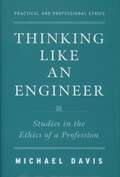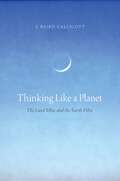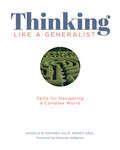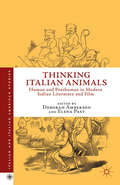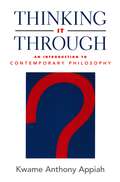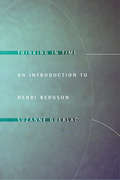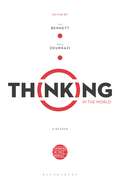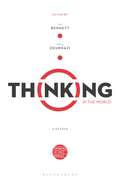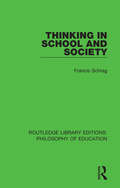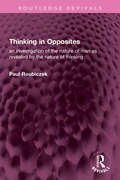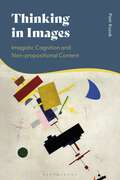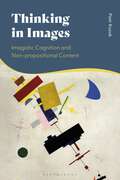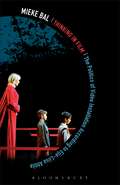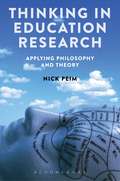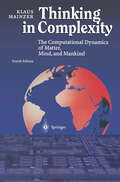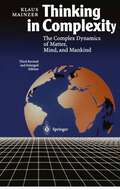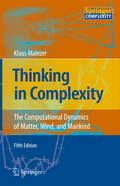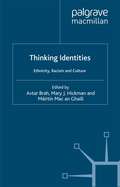- Table View
- List View
Thinking Like an Engineer: A Collection of Addresses and Essays (Practical and Professional Ethics)
by the late Henry SidgwickA classic work in the field of practical and professional ethics, this collection of nine essays by English philosopher and educator Henry Sidgwick (1838-1900) was first published in 1898 and forms a vital complement to Sidgwick's major treatise on moral theory, The Methods of Ethics. Reissued here as Volume One in a new series sponsored by the Association for Practical and Professional Ethics, the book is composed chiefly of addresses to members of two ethical societies that Sidgwick helped to found in Cambridge and London in the 1880s. Clear, taut, and lively, these essays demonstrate the compassion and calm reasonableness that Sidgwick brought to all his writings. As Sidgwick explains in his opening essay, the societies he addressed aimed to allow academics, professionals, and others to pursue joint efforts at reaching "some results of value for practical guidance and life." Sidgwick hoped that members might discuss such questions as when, if ever, public officials might be justified in lying or in breaking promises, whether scientists could legitimately inflict suffering on animals for research purposes, when nations might have just cause in going to war, and a score of other issues of ethics in public and private life still debated a century later. This valuable reissue returns Practical Ethics to its rightful place in Sidgwick's oeuvre. Noted ethicist Sissela Bok provides a superb Introduction, ranging over the course of Sidgwick's life and career and underscoring the relevance of Practical Ethics to contemporary debate. She writes: "Practical Ethics, the last book that Henry Sidgwick published before his death in 1900, contains the distillation of a lifetime of reflection on ethics and on what it would take for ethical debate to be 'really of use in the solution of practical questions.'" This rich, engaging work is essential reading for all concerned with the relationship between ethical theory and. practice, and with the questions that have driven the study of professional ethics in recent years.
Thinking Like a Planet: The Land Ethic and the Earth Ethic
by J. Baird CallicottBringing together ecology, evolutionary moral psychology, and environmental ethics, J. Baird Callicott counters the narrative of blame and despair that prevails in contemporary discussions of climate ethics and offers a fresh, more optimistic approach. Whereas other environmental ethicists limit themselves to what Callicott calls Rational Individualism in discussing the problem of climate change only to conclude that, essentially, there is little hope that anything will be done in the face of its "perfect moral storm" (in Stephen Gardiner's words), Callicott refuses to accept this view. Instead, he encourages us to look to the Earth itself, and consider the crisis on grander spatial and temporal scales, as we have failed to in the past. Callicott supports this theory by exploring and enhancing Aldo Leopold's faint sketch of an Earth ethic in "Some Fundamentals of Conservation in the Southwest," a seldom-studied text from the early days of environmental ethics that was written in 1923 but not published until 1979 after the environmental movement gathered strength.
Thinking Like a Generalist: Skills for Navigating a Complex World
by Angela Kohnen Wendy SaulWhat can we teach kids today that will have utility ten or fifteen years from now? Angela Kohnen and Wendy Saul propose an approach to information literacy that goes beyond the teaching of discreet, easily outdated skills. Instead they use activity to help students build identities as curious individuals empowered to ask their own questions and able to navigate their information-filled world in pursuit of credible answers. A generalist is curious, open-minded, skeptical, and persistent in their quest for information. Thinking Like a Generalist: Skills for Navigating a Complex World demonstrates what it means to take a generalist stance in instruction and provides a set of teaching tools to be able to pass those skills to students'sskills that will transfer beyond the walls of the classroom. Inside you'll find the following: A thorough introduction to what it means to be a generalist, and how to develop the practices and tools that help generalists navigate the world we live inA focus on the teacher becoming a generalist and tips for modeling those practices in the classroomDetailed instructions on how to write a unit of study that emphasizes generalist literacy skills and includes an overview and examples of five different unitsHow to use the authors' read-aloud-think-aloud strategy to orient students to generalist tools and practicesThe ideas, strategies, and examples Thinking Like a Generalist will give you the tools to think like a generalist and then pass that knowledge on to your students, guiding them to become inquisitive, lifelong learners and preparing them for a future that we can't yet imagine.
Thinking Like a Generalist: Skills for Navigating a Complex World
by Angela Kohnen Wendy SaulWhat can we teach kids today that will have utility ten or fifteen years from now? Angela Kohnen and Wendy Saul propose an approach to information literacy that goes beyond the teaching of discreet, easily outdated skills. Instead they use activity to help students build identities as curious individuals empowered to ask their own questions and able to navigate their information-filled world in pursuit of credible answers. A generalist is curious, open-minded, skeptical, and persistent in their quest for information. Thinking Like a Generalist: Skills for Navigating a Complex World demonstrates what it means to take a generalist stance in instruction and provides a set of teaching tools to be able to pass those skills to students'sskills that will transfer beyond the walls of the classroom. Inside you'll find the following: A thorough introduction to what it means to be a generalist, and how to develop the practices and tools that help generalists navigate the world we live inA focus on the teacher becoming a generalist and tips for modeling those practices in the classroomDetailed instructions on how to write a unit of study that emphasizes generalist literacy skills and includes an overview and examples of five different unitsHow to use the authors' read-aloud-think-aloud strategy to orient students to generalist tools and practicesThe ideas, strategies, and examples Thinking Like a Generalist will give you the tools to think like a generalist and then pass that knowledge on to your students, guiding them to become inquisitive, lifelong learners and preparing them for a future that we can't yet imagine.
Thinking Italian Animals: Human and Posthuman in Modern Italian Literature and Film (Italian and Italian American Studies)
by Deborah Amberson Elena PastThis bracing volume collects work on Italian writers and filmmakers that engage with nonhuman animal subjectivity. These contributions address 3 major strands of philosophical thought: perceived borders between man and animals, historical and fictional crises, and human entanglement with the nonhuman and material world.
Thinking It Through: An Introduction to Contemporary Philosophy
by Kwame Anthony AppiahThinking it Through is a thorough, vividly written introduction to contemporary philosophy and some of the most crucial questions of human existence, including the nature of mind and knowledge, the status of moral claims, the existence of God, the role of science, and the mysteries of language. Noted philosopher Kwame Anthony Appiah shows us what it means to "do" philosophy in our time and why it should matter to anyone who wishes to live a more thoughtful life. Opposing the common misconceptions that being a philosopher means espousing a set of philosophical beliefs--or being a follower of a particular thinker--Appiah argues that "the result of philosophical exploration is not the end of inquiry in a settled opinion, but a mind resting more comfortably among many possibilities, or else the reframing of the question, and a new inquiry." Ideal for introductory philosophy courses, Thinking It Through is organized around eight central topics--mind, knowledge, language, science, morality, politics, law, and metaphysics. It traces how philosophers in the past have considered each subject (how Hobbes, Wittgenstein, and Frege, for example, approached the problem of language) and then explores some of the major questions that still engage philosophers today. More importantly, Appiah not only explains what philosophers have thought but how they think, giving students examples that they can use in their own attempts to navigate the complex issues confronting any reflective person in the twenty-first century. Filled with concrete examples of how philosophers work, Thinking it Through guides students through the process of philosophical reflection and enlarges their understanding of the central questions of human life.
Thinking It Through: An Introduction to Contemporary Philosophy
by Kwame Anthony AppiahThinking it Through is a thorough, vividly written introduction to contemporary philosophy and some of the most crucial questions of human existence, including the nature of mind and knowledge, the status of moral claims, the existence of God, the role of science, and the mysteries of language. Noted philosopher Kwame Anthony Appiah shows us what it means to "do" philosophy in our time and why it should matter to anyone who wishes to live a more thoughtful life. Opposing the common misconceptions that being a philosopher means espousing a set of philosophical beliefs--or being a follower of a particular thinker--Appiah argues that "the result of philosophical exploration is not the end of inquiry in a settled opinion, but a mind resting more comfortably among many possibilities, or else the reframing of the question, and a new inquiry." Ideal for introductory philosophy courses, Thinking It Through is organized around eight central topics--mind, knowledge, language, science, morality, politics, law, and metaphysics. It traces how philosophers in the past have considered each subject (how Hobbes, Wittgenstein, and Frege, for example, approached the problem of language) and then explores some of the major questions that still engage philosophers today. More importantly, Appiah not only explains what philosophers have thought but how they think, giving students examples that they can use in their own attempts to navigate the complex issues confronting any reflective person in the twenty-first century. Filled with concrete examples of how philosophers work, Thinking it Through guides students through the process of philosophical reflection and enlarges their understanding of the central questions of human life.
Thinking in Time: An Introduction to Henri Bergson
by Suzanne Guerlac"In recent years, we have grown accustomed to philosophical language that is intensely self-conscious and rhetorically thick, often tragic in tone. It is enlivening to read Bergson, who exerts so little rhetorical pressure while exacting such a substantial effort of thought.... Bergson's texts teach the reader to let go of entrenched intellectual habits and to begin to think differently—to think in time.... Too much and too little have been said about Bergson. Too much, because of the various appropriations of his thought. Too little, because the work itself has not been carefully studied in recent decades."—from Thinking in TimeHenri Bergson (1859–1941), whose philosophical works emphasized motion, time, and change, won the Nobel Prize for Literature in 1927. His work remains influential, particularly in the realms of philosophy, cultural studies, and new media studies. In Thinking in Time, Suzanne Guerlac provides readers with the conceptual and contextual tools necessary for informed appreciation of Bergson's work. Guerlac's straightforward philosophical expositions of two Bergson texts, Time and Free Will (1888) and Matter and Memory (1896), focus on the notions of duration and memory—concepts that are central to the philosopher's work. Thinking in Time makes plain that it is well worth learning how to read Bergson effectively: his era and our own share important concerns. Bergson's insistence on the opposition between the automatic and the voluntary and his engagement with the notions of "the living," affect, and embodiment are especially germane to discussions of electronic culture.
Thinking in the World: A Reader (Thinking in the World)
by Jill Bennett Mary ZournaziEngaging with contemporary issues responsibly and creatively can become a very abstract activity. We can sometimes find ourselves talking in terms of theories and philosophies which bear very little resemblance to how life is actually lived and experienced. In Thinking in the World, Jill Bennett and Mary Zournazi curate writings and conversations with some of the most influential thinkers in the world and ask them not just why we should engage with the world ,but also how we might do this. Rather than simply thinking about the world, the authors examine the ways in which we think in and with the world. Whether it's how to be environmentally responsible, how to think in film, or how to dance with a non-human, the need to engage meaningfully in a lived way is at the forefront of this collection.Thinking in the World showcases some of the most compelling arguments for a philosophy in action. Including wholly original, never-before-released material from Michel Serres, Alphonso Lingis, and Mieke Bal, the different chapters in this book constitute dialogues and approachable essays, as well as impassioned arguments for a particular way of approaching thinking in the world.
Thinking in the World: A Reader (Thinking in the World)
Engaging with contemporary issues responsibly and creatively can become a very abstract activity. We can sometimes find ourselves talking in terms of theories and philosophies which bear very little resemblance to how life is actually lived and experienced. In Thinking in the World, Jill Bennett and Mary Zournazi curate writings and conversations with some of the most influential thinkers in the world and ask them not just why we should engage with the world ,but also how we might do this. Rather than simply thinking about the world, the authors examine the ways in which we think in and with the world. Whether it's how to be environmentally responsible, how to think in film, or how to dance with a non-human, the need to engage meaningfully in a lived way is at the forefront of this collection.Thinking in the World showcases some of the most compelling arguments for a philosophy in action. Including wholly original, never-before-released material from Michel Serres, Alphonso Lingis, and Mieke Bal, the different chapters in this book constitute dialogues and approachable essays, as well as impassioned arguments for a particular way of approaching thinking in the world.
Thinking in School and Society (Routledge Library Editions: Philosophy of Education)
by Francis SchragIn this book, first published in 1988, the author integrates relevant ideas from philosophy, psychology, sociology, economics and political science to provide a comprehensive analysis of the problem of education for thinking. Professor Schrag takes account of the classroom as well as the larger society, and includes practical recommendations for creating new settings designed to enhance students’ thoughtfulness.
Thinking in School and Society (Routledge Library Editions: Philosophy of Education)
by Francis SchragIn this book, first published in 1988, the author integrates relevant ideas from philosophy, psychology, sociology, economics and political science to provide a comprehensive analysis of the problem of education for thinking. Professor Schrag takes account of the classroom as well as the larger society, and includes practical recommendations for creating new settings designed to enhance students’ thoughtfulness.
Thinking in Opposites: an investigation of the nature of man as revealed by the nature of thinking (Routledge Revivals)
by Paul RoubiczekFirst published in 1952, Thinking in Opposites insists on the need for a carefully thought-out, rather than a merely authoritarian, basis for faith; but also insists that an indispensable preliminary is to know the laws which govern and limit the scope of human thinking in relation to three areas: the external world as it is; the internal world of feeling; and the interrelation of each of these with the other. This book is not a technical work in philosophy and the theory of knowledge; but it deals with problems in those fields which have usually been handled only in technical language. Therefore, this is a book both for the expert and for the intelligent and thoughtful layman: for the man who has a sense of responsibility for what he believes, and who is able to justify his faith amid the chaos of our times.
Thinking in Opposites: an investigation of the nature of man as revealed by the nature of thinking (Routledge Revivals)
by Paul RoubiczekFirst published in 1952, Thinking in Opposites insists on the need for a carefully thought-out, rather than a merely authoritarian, basis for faith; but also insists that an indispensable preliminary is to know the laws which govern and limit the scope of human thinking in relation to three areas: the external world as it is; the internal world of feeling; and the interrelation of each of these with the other. This book is not a technical work in philosophy and the theory of knowledge; but it deals with problems in those fields which have usually been handled only in technical language. Therefore, this is a book both for the expert and for the intelligent and thoughtful layman: for the man who has a sense of responsibility for what he believes, and who is able to justify his faith amid the chaos of our times.
Thinking in Images: Imagistic Cognition and Non-propositional Content
by Piotr KozakWhat does it mean to think with images? There is a well-established tradition of studying thought processes through the nature of language, and we know much more about thinking with language than about thinking with images. Piotr Kozak takes an important step towards rectifying this position.Presenting a unified theory of different types of images, such as diagrams, maps, technical drawings and photographs, Kozak argues that images provide a genuine and autonomous form of content and knowledge. In contrast to the propositional view of thinking and resemblance-based accounts, he puts forward a measurement-theoretic account of images as operations that exemplify measures, revealing the outcomes of measurement operations performed on a depicted situation. Bringing together insights from philosophy of science, picture-theory, cognitive science and cognitive psychology, this book demonstrates that we can only understand what an image is if we truly understand the role they play in our thought processes, challenging the prevailing view that the utility of images is only instrumental and cognitively inferior.
Thinking in Images: Imagistic Cognition and Non-propositional Content
by Piotr KozakWhat does it mean to think with images? There is a well-established tradition of studying thought processes through the nature of language, and we know much more about thinking with language than about thinking with images. Piotr Kozak takes an important step towards rectifying this position.Presenting a unified theory of different types of images, such as diagrams, maps, technical drawings and photographs, Kozak argues that images provide a genuine and autonomous form of content and knowledge. In contrast to the propositional view of thinking and resemblance-based accounts, he puts forward a measurement-theoretic account of images as operations that exemplify measures, revealing the outcomes of measurement operations performed on a depicted situation. Bringing together insights from philosophy of science, picture-theory, cognitive science and cognitive psychology, this book demonstrates that we can only understand what an image is if we truly understand the role they play in our thought processes, challenging the prevailing view that the utility of images is only instrumental and cognitively inferior.
Thinking in Film: The Politics of Video Art Installation According to Eija-Liisa Ahtila
by Mieke BalWhat is a moving image, and how does it move us? In Thinking In Film, celebrated theorist Mieke Bal engages in an exploration - part dialogue, part voyage - with the video installations of Finnish artist Eija-Liisa Ahtila to understand movement as artistic practice and as affect. Through fifteen years of Ahtila's practice, including such seminal works as The Annunciation, Where Is Where? and The House, Bal searches for the places where theoretical and artistic practices intersect, to create radical spaces in which genuinely democratic acts are performed. Bringing together different understandings of 'figure' from form to character, Bal examines the syntax of the exhibition and its ability to bring together installations, the work itself, the physical and ontological thresholds of the installation space and the use of narrative and genre. The double meaning of 'movement', in Bal's unique thought, catalyses anunderstanding of video installation work as inherently plural, heterogenous and possessed of revolutionary political potential. The video image as an art form illuminates the question of what an image is, and the installation binds viewers to their own interactions with the space. In this context Bal argues that the intersection between movement and space creates an openness to difference and doubt. By 'thinking in' art, we find ideas not illustrated by but actualized in artworks. Bal practices this theory in action to demonstrate how the video installation can move us to think beyond ordinary boundaries and venture into new spaces. There is no act more radical than figuring a vision of the 'other' as film allows artto do. Thinking In Film is Mieke Bal ather incisive, innovative best as she opens up the miraculous political potential of the condensed art of the moving image.
Thinking in Film: The Politics of Video Art Installation According to Eija-Liisa Ahtila
by Mieke BalWhat is a moving image, and how does it move us? In Thinking In Film, celebrated theorist Mieke Bal engages in an exploration - part dialogue, part voyage - with the video installations of Finnish artist Eija-Liisa Ahtila to understand movement as artistic practice and as affect. Through fifteen years of Ahtila's practice, including such seminal works as The Annunciation, Where Is Where? and The House, Bal searches for the places where theoretical and artistic practices intersect, to create radical spaces in which genuinely democratic acts are performed. Bringing together different understandings of 'figure' from form to character, Bal examines the syntax of the exhibition and its ability to bring together installations, the work itself, the physical and ontological thresholds of the installation space and the use of narrative and genre. The double meaning of 'movement', in Bal's unique thought, catalyses anunderstanding of video installation work as inherently plural, heterogenous and possessed of revolutionary political potential. The video image as an art form illuminates the question of what an image is, and the installation binds viewers to their own interactions with the space. In this context Bal argues that the intersection between movement and space creates an openness to difference and doubt. By 'thinking in' art, we find ideas not illustrated by but actualized in artworks. Bal practices this theory in action to demonstrate how the video installation can move us to think beyond ordinary boundaries and venture into new spaces. There is no act more radical than figuring a vision of the 'other' as film allows artto do. Thinking In Film is Mieke Bal ather incisive, innovative best as she opens up the miraculous political potential of the condensed art of the moving image.
Thinking in Education Research: Applying Philosophy and Theory
by Nick PeimThinking in Education Research examines the resources available from philosophy and theory that can be practically applied to any educational research project. Nick Peim argues that the current well-established divide between theory and the empirical in research methods is unhelpful to students. Instead, Thinking in Education Research looks at major lines of thinking in modern European philosophy, from Kant to Freud and Derrida to Malabou, and how they provide a rich resource for every stage of conducting research. By getting students engaged in 'how to think' and 'how to do', Peim illustrates that thinking is in fact a vital part of how you do research and is not an aside.Essential aspects of the research endeavour are re-examined in the light of key philosophical positions to offer constructive potential, including:- defining the object; - giving an account of the field;- the relation to truth;- the process of writing and constructing a case; and- the value attributed to formal knowledge. Thinking in Education Research does not try to resolve the unresolved issues of research thinking but rather encourages readers to productively engage with them so that we can enhance the possibilities of research practice and find opportunities for its expansion and refinement. Throughout the chapters, clear and concise summaries of key philosophical positions and ideas are complemented with boxed accounts of how the philosophical debates discussed can be applied to real research projects. These features encourage the reader to consider how they can develop thinking and apply theory at every stage of their own research. This is essential reading for any educational research methods student or practicing researcher for important ways of thinking afresh about research methodology.
Thinking in Education Research: Applying Philosophy and Theory
by Nick PeimThinking in Education Research examines the resources available from philosophy and theory that can be practically applied to any educational research project. Nick Peim argues that the current well-established divide between theory and the empirical in research methods is unhelpful to students. Instead, Thinking in Education Research looks at major lines of thinking in modern European philosophy, from Kant to Freud and Derrida to Malabou, and how they provide a rich resource for every stage of conducting research. By getting students engaged in 'how to think' and 'how to do', Peim illustrates that thinking is in fact a vital part of how you do research and is not an aside.Essential aspects of the research endeavour are re-examined in the light of key philosophical positions to offer constructive potential, including:- defining the object; - giving an account of the field;- the relation to truth;- the process of writing and constructing a case; and- the value attributed to formal knowledge. Thinking in Education Research does not try to resolve the unresolved issues of research thinking but rather encourages readers to productively engage with them so that we can enhance the possibilities of research practice and find opportunities for its expansion and refinement. Throughout the chapters, clear and concise summaries of key philosophical positions and ideas are complemented with boxed accounts of how the philosophical debates discussed can be applied to real research projects. These features encourage the reader to consider how they can develop thinking and apply theory at every stage of their own research. This is essential reading for any educational research methods student or practicing researcher for important ways of thinking afresh about research methodology.
Thinking in Complexity: The Computational Dynamics of Matter, Mind, and Mankind
by Klaus MainzerThis new edition also treats smart materials and artificial life. A new chapter on information and computational dynamics takes up many recent discussions in the community.
Thinking in Complexity: The Complex Dynamics of Matter, Mind, and Mankind
by Klaus MainzerThis new edition also treats smart materials and artificial life. A new chapter on information and computational dynamics takes up many recent discussions in the community.
Thinking in Complexity: The Computational Dynamics of Matter, Mind, and Mankind
by Klaus MainzerThis new edition also treats smart materials and artificial life. A new chapter on information and computational dynamics takes up many recent discussions in the community.
Thinking Identities: Ethnicity, Racism and Culture (Explorations in Sociology.)
by Avtar BrahThis book brings together research about a diverse range of groups who are rarely analysed together: Welsh, Irish, Jewish, Arab, White, African and Indian. The aim of the book is to critique orthodox explanations in the field, drawing upon the best of 'old' and 'new' theory. Key contemporary questions include: issues about the black-white model of racism; the underplaying of anti-semitism; the need to examine ethnic majorities, as well as whiteness and the reconfiguration of the United Kingdom.
Thinking How to Live
by Allan GibbardPhilosophers have long suspected that thought and discourse about what we ought to do differ in some fundamental way from statements about what is. But the difference has proved elusive, in part because the two kinds of statement look alike. Focusing on judgments that express decisions—judgments about what is to be done, all things considered—Allan Gibbard offers a compelling argument for reconsidering, and reconfiguring, the distinctions between normative and descriptive discourse—between questions of "ought" and "is." Gibbard considers how our actions, and our realities, emerge from the thousands of questions and decisions we form for ourselves. The result is a book that investigates the very nature of the questions we ask ourselves when we ask how we should live, and that clarifies the concept of "ought" by understanding the patterns of normative concepts involved in beliefs and decisions. An original and elegant work of metaethics, this book brings a new clarity and rigor to the discussion of these tangled issues, and will significantly alter the long-standing debate over "objectivity" and "factuality" in ethics.
